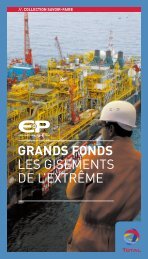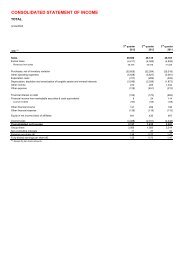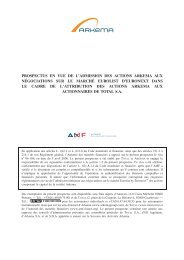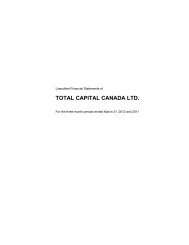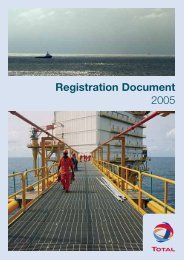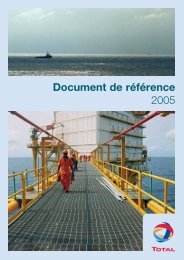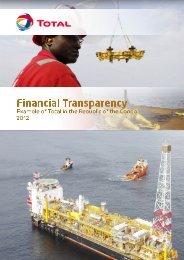Registration document 2007 - Total.com
Registration document 2007 - Total.com
Registration document 2007 - Total.com
You also want an ePaper? Increase the reach of your titles
YUMPU automatically turns print PDFs into web optimized ePapers that Google loves.
On February 13, <strong>2007</strong>, the Board of Directors established and<br />
authorized the publication of the consolidated financial<br />
statements of TOTAL S.A. for the year ended December 31,<br />
2006.<br />
INTRODUCTION<br />
The consolidated financial statements of TOTAL S.A. and its<br />
subsidiaries (the Group) have been prepared on the basis of<br />
IFRS (International Financial Reporting Standards) as adopted by<br />
the European Union, as of December 31, 2006.<br />
The preparation of financial statements in accordance with IFRS<br />
requires management to make estimates and apply assumptions<br />
that affect the reported amounts of assets, liabilities and<br />
contingent liabilities at the date of preparation of the financial<br />
statements and reported in<strong>com</strong>e and expenses for the period.<br />
Management reviews these estimates and assumptions on an<br />
ongoing basis, by reference to past experience and various other<br />
factors considered as reasonable which form the basis for<br />
assessing the book value of assets and liabilities. Actual results<br />
may differ significantly from these estimates, if different<br />
assumptions or circumstances apply.<br />
Lastly, where a specific transaction is not dealt with in any<br />
standards or interpretation, management applies its judgment to<br />
define and apply accounting policies that will lead to relevant and<br />
reliable information, so that the financial statements:<br />
• give a true and fair view of the Group’s financial position,<br />
financial performance and cash flows;<br />
• reflect the substance of transactions;<br />
• are neutral;<br />
• are prepared on a prudent basis; and<br />
• are <strong>com</strong>plete in all material aspects.<br />
1) Accounting policies<br />
The consolidated financial statements have been prepared on a<br />
historical cost basis, except for certain financial assets and<br />
liabilities that have been measured at fair value.<br />
The accounting policies used by the Group are described below.<br />
A. Principles of consolidation<br />
The subsidiaries that are directly controlled by the parent<br />
<strong>com</strong>pany or indirectly controlled by other consolidated<br />
subsidiaries are fully consolidated.<br />
Appendix 1 – Consolidated financial statements<br />
Notes to the consolidated financial statement<br />
Notes to the consolidated financial statements<br />
Investments in jointly controlled entities are proportionately<br />
consolidated.<br />
Investments in associates, in which the Group has significant<br />
influence, are accounted for by the equity method. Significant<br />
influence is presumed when the Group holds, directly or indirectly<br />
(e.g. through subsidiaries), 20% or more of the voting rights.<br />
Companies in which ownership interest is less than 20%, but<br />
over which the Company has the ability to exercise significant<br />
influence, are also accounted for by the equity method.<br />
All significant inter<strong>com</strong>pany balances, transactions and in<strong>com</strong>e<br />
have been eliminated.<br />
B. Business <strong>com</strong>binations<br />
Business <strong>com</strong>binations are accounted for using the purchase<br />
method. This method implies the recognition of the assets,<br />
liabilities and contingent liabilities of the <strong>com</strong>panies acquired by<br />
the Group at their fair value.<br />
The difference between the acquisition cost of the shares and the<br />
total valuation, at fair value, of the acquired share of the assets,<br />
liabilities and contingent liabilities identified on the acquisition<br />
date is recorded as goodwill.<br />
If the cost of an acquisition is less than the fair value of the net<br />
assets of the subsidiary acquired, an additional analysis is<br />
performed on the identification and valuation of the identifiable<br />
elements of the assets and liabilities. Any residual negative<br />
goodwill is recorded as net operating in<strong>com</strong>e.<br />
The analysis of goodwill is finalized within one year from the<br />
acquisition date.<br />
9<br />
C. Foreign currency translation<br />
The financial statements of subsidiaries are prepared in the<br />
currency that most clearly reflects their business environment.<br />
This is referred to as their functional currency.<br />
(i) Monetary transactions<br />
Transactions denominated in foreign currencies are translated at<br />
the exchange rate prevailing at the transaction date. At each<br />
balance sheet date, monetary assets and liabilities are translated<br />
at the closing rate and the resulting exchange differences are<br />
recognized in “Other in<strong>com</strong>e” or “Other expenses”.<br />
(ii) Translation of financial statements denominated in<br />
foreign currencies<br />
Assets and liabilities of foreign entities are translated into euros<br />
on the basis of the exchange rates at the end of the period. The<br />
in<strong>com</strong>e and cash flow statements are translated using the<br />
average exchange rates of the period. Foreign exchange<br />
TOTAL – <strong>Registration</strong> Document 2006 173




